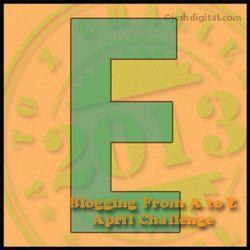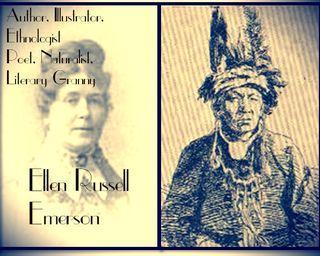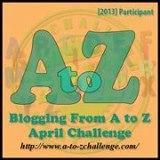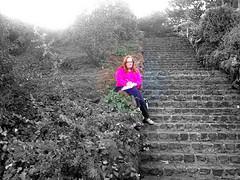 When I decided to do a profile on Ellen Emerson, I
knew I wouldn’t have many resources to guide me.
When I decided to do a profile on Ellen Emerson, I
knew I wouldn’t have many resources to guide me.
Women without much of an ongoing following are among my favorite Literary Grannies to highlight here. Ellen Emerson did phenomenal work and had at least one international “first woman” status, but I would guess most people just shrug and think she is one of “THE” Emersons, meaning the lineage Ralph Waldo Emerson, et al, sprang from. She was actually Waldo’s contemporary and there is no word of them ever interacting or even knowing the other existed.
 On the Left is one of the few portraits of Ellen Russell Emerson, on the right, a drawing she made of one of the people she met while studying Native Americans.
Ellen Russell Emerson was born in New Sharon,
Maine in 1837. When she was a little
girl she met Henry Wadsworth Longfellow whose epic poem, The Song of Hiawatha,
ignited her lifelong interest in Native Americans. I can imagine a wide eyed
little Ellen listening to those famous opening words:
On the Left is one of the few portraits of Ellen Russell Emerson, on the right, a drawing she made of one of the people she met while studying Native Americans.
Ellen Russell Emerson was born in New Sharon,
Maine in 1837. When she was a little
girl she met Henry Wadsworth Longfellow whose epic poem, The Song of Hiawatha,
ignited her lifelong interest in Native Americans. I can imagine a wide eyed
little Ellen listening to those famous opening words:
On the shores of Gitche Gumee,
Of the shining Big-Sea-Water,
Stood Nokomis, the old woman,
Pointing with her finger westward,
O'er the water pointing westward,
To the purple clouds of sunset.
Fiercely the red sun descending
Burned his way along the heavens,
Set the sky on fire behind him
This little girl went on to become a wife and a mother but her passion for learning continued beyond the traditional walls of education.When she was twenty-seven years old in 1884 her 700 page Ethnological Study titled Indian Myths: Or Legends, Traditions and Symbols of the Aborigines of America Compared with Those of Other Countries.
Her widely regarded volumbe included her knowledge of Native American cultures (in her day called by many other names which are now very politically incorrect) and she compares and contrasts these myths and legends with those in other civilizations in the world such as Hindus, Chinese and Persian. She not only wrote this enormous book, she also served as Illustrator and mapmaker.
When her daughter was grown, she went to Europe and began studying with the leading ethnologists in Europe.
She even studied Egyptology in Paris. The European scholars were very impressed by her literary work as well as her approach using words and also sketch books and paint to render her subjects in a variety of ways. She was, after all, a gifted illustrator and thoroughly enjoyed making comparisons and contrasts in order to learn about her subjects more deeply.
Through her book Masks, Heads and Faces, Ellen sees the movement from mask as protection to the creation of art. Perhaps this lead to her stretch into the world of published poetry.
She was honored as the first woman in the Société Américaine of Paris
Her opening sentence in her well known (and still in print) book of essays, Nature and Human Nature, goes like this: “Estrangement is impossible between nature and human nature for any length of time, the spring and source of all life being one.” Such poetry in a scientific book! Perhaps there is a bit of Ellen Emerson in today’s writer, Diane Ackerman. Both women are naturalists and poets, biologists and studies of humans, plant life, culture – how interesting to make that connection.
After she returned from France, she settled into a quiet life living in Boston with her daughter in a home filled with enjoyable study and fellowship together. I attempted to find her daughter’s name, but in this research, I could not. I do have an upcoming trip to Boston so I may seek out more details of her life when I am there.
She died in Cambridge, Massachusetts in 1907. I know how she spent her life would have made Longfellow very proud.
 This post is a part of my series Our Literary Grannies from A t0 Z which was inspired by the Blogging from A to Z Challenge. Find out more about the Challenge by either clicking here or on the icon.
This post is a part of my series Our Literary Grannies from A t0 Z which was inspired by the Blogging from A to Z Challenge. Find out more about the Challenge by either clicking here or on the icon.

Be sure to "Like" WritingCampwithJJS on Facebook. (Thank you!)
Follow on Instagram
And naturally, on Pinterest, too!